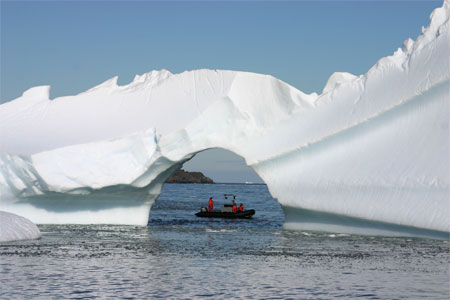Sea level rise revisedNew study says less ice in West Antarctica would melt into oceanPosted May 29, 2009
A new study in the journal Science challenges the long-held idea that the West Antarctic Ice Sheet (WAIS) would raise sea level by as much as five or six meters if it were to collapse. Instead, the authors contend the ice would increase sea level by 3.3 meters, about half of previous estimates, with coastal areas around the United States most severely affected. The study authors used models based on glaciological theory to simulate how the ice sheet would respond if the floating ice shelves fringing the continent broke free. Currently, vast ice shelves block the ice sheet from spilling into the Weddell and Ross seas, limiting total ice loss to the ocean. Losing the ice shelves would be like breaking a series of dams, triggering an acceleration of the ice sheet toward the ocean. The most unstable areas of the ice sheet are those grounded below sea level on bedrock with negative “bedslope,” where the bedrock slopes downwards inland, the authors explained. Once undammed, these areas would quickly become buoyant, forming new floating ice shelves farther inland and, in time, precipitating further break up and collapse. For their calculations, the researchers assumed that only these areas would collapse and contribute to sea level rise. In other words, they assumed ice-covered areas grounded above sea level, or on bedrock that slopes upwards inland, would likely retain substantial ice masses — an area of ice-covered islands. “There’s a vast body of research that’s looked at the likelihood of a WAIS collapse and what implications such a catastrophic event would have for the globe,” said Jonathan Bamber If all of the ice melted, even those places where it is grounded on bedrock above sea level, “the total from the WAIS is 4.8 [meters] if you do the calculation properly. No more than that,” Bamber said in an e-mail to The Antarctic Sun The scenario and timescale under which sea level would rise 3.3 meters is still up for debate, added Bamber with the University of Bristol “Ah, well, now that’s the question: timescale and what would be required to cause a collapse,” he said. “We don’t offer any new insights on these two topics in our study, which is addressing a different set of questions. I can speculate on this based on other studies but no more. So, an early study put the time scale at something like 400 [to] 500 years potentially.” Bamber and other researchers have noted that even the revised estimate would cause problems for coastal areas. The United Nations’ Intergovernmental Panel on Climate Change (IPCC) “Interestingly, the pattern of sea level rise is independent of how fast or how much of the WAIS collapses,” said Bamber, who is currently a Visiting Fellow at the University of Colorado at Boulder’s Cooperative Institute for Research in Environmental Sciences (CIRES) That’s because the redistribution of ice mass from Antarctica to the oceans would drive regional variations in sea level. With less mass at the South Pole, Earth’s gravity field would weaken in the Southern Hemisphere and strengthen in the North, causing water to “pile up” in the northern oceans. This redistribution of mass would also affect Earth’s rotation, which in turn would cause water to build up along the North American continent and in the Indian Ocean. In an article The prime question, he told the Times, remains what will happen in the next 100 years or so, and other recent work implies that a lot of ice can be shed within that time. “Even in Bamber’s world there is more than enough ice to cause serious harm to the world’s coastlines,” said Bindschadler, a principal investigator for a National Science Foundation |



For USAP Participants |
For The Public |
For Researchers and EducatorsContact UsU.S. National Science FoundationOffice of Polar Programs Geosciences Directorate 2415 Eisenhower Avenue, Suite W7100 Alexandria, VA 22314 Sign up for the NSF Office of Polar Programs newsletter and events. Feedback Form |


